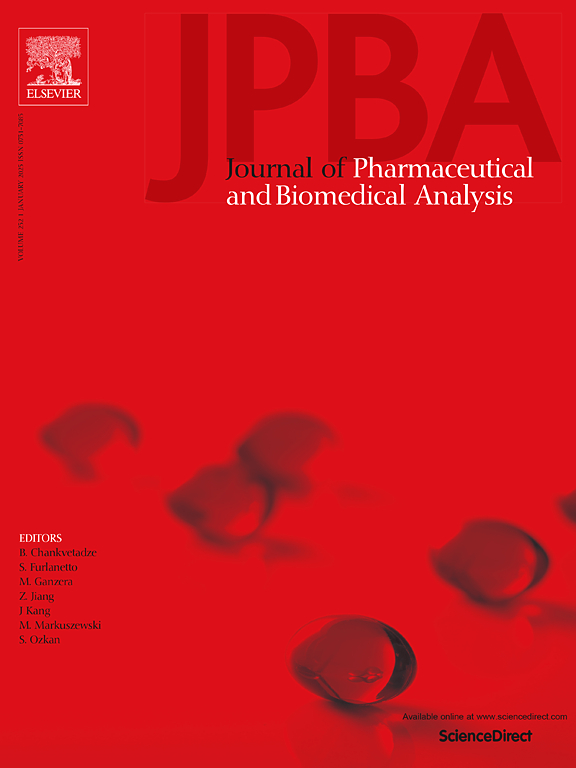Development of a novel strategy for the determination of Ag(I), Cu(II) and Ni(II) in urine after the extraction mediated by a semipermeable membrane
IF 3.1
3区 医学
Q2 CHEMISTRY, ANALYTICAL
Journal of pharmaceutical and biomedical analysis
Pub Date : 2025-03-27
DOI:10.1016/j.jpba.2025.116837
引用次数: 0
Abstract
The determination of metals in urine using spectrometric techniques presents challenges due to the complex matrix of substances in the samples. This work introduces a novel method for determining Ag(I), Cu(II), and Ni(II) in urine using a semipermeable membrane device (SPMD) filled with chloroform (CHCl₃). The analytes were separated after complexation with ammonium pyrrolidinedithiocarbamate (APDC), forming a substance capable of migrating through the membrane and being absorbed by the internal phase. After extraction, the internal phase (solvent) was transferred to a volumetric flask, diluted with ethanol, and analyzed by graphite furnace atomic absorption spectrometry (GF AAS). Optimization of the extraction process included the acceptor phase, sample pH, APDC concentration, extraction time, and GF AAS temperature program. The limits of detection were 0.19, 0.23, and 0.15 µg L⁻¹ for Ag(I), Cu(II), and Ni(II), respectively, while the limits of quantification were 0.64, 0.77, and 0.51 µg L⁻¹ . Analysis of five urine samples and recovery tests, involving spiking with 5 and 10 µg L⁻¹ of each analyte, resulted in recovery percentages between 85 % and 106 %, confirming the suitability of the method for quantifying metals in complex samples like urine.
求助全文
约1分钟内获得全文
求助全文
来源期刊
CiteScore
6.70
自引率
5.90%
发文量
588
审稿时长
37 days
期刊介绍:
This journal is an international medium directed towards the needs of academic, clinical, government and industrial analysis by publishing original research reports and critical reviews on pharmaceutical and biomedical analysis. It covers the interdisciplinary aspects of analysis in the pharmaceutical, biomedical and clinical sciences, including developments in analytical methodology, instrumentation, computation and interpretation. Submissions on novel applications focusing on drug purity and stability studies, pharmacokinetics, therapeutic monitoring, metabolic profiling; drug-related aspects of analytical biochemistry and forensic toxicology; quality assurance in the pharmaceutical industry are also welcome.
Studies from areas of well established and poorly selective methods, such as UV-VIS spectrophotometry (including derivative and multi-wavelength measurements), basic electroanalytical (potentiometric, polarographic and voltammetric) methods, fluorimetry, flow-injection analysis, etc. are accepted for publication in exceptional cases only, if a unique and substantial advantage over presently known systems is demonstrated. The same applies to the assay of simple drug formulations by any kind of methods and the determination of drugs in biological samples based merely on spiked samples. Drug purity/stability studies should contain information on the structure elucidation of the impurities/degradants.

 求助内容:
求助内容: 应助结果提醒方式:
应助结果提醒方式:


